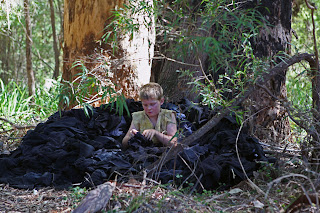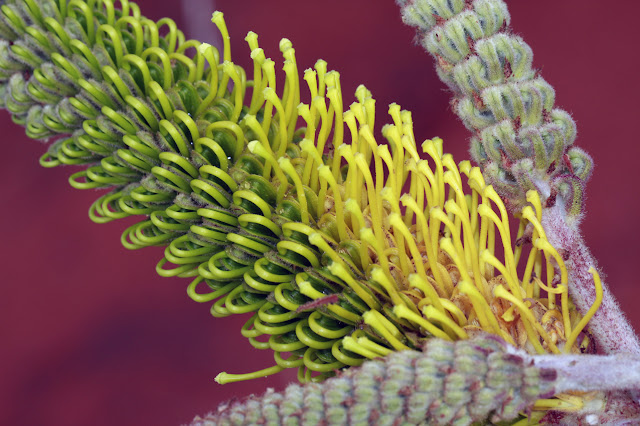 |
| Trucks: our car looking out |
Once past Wubin, the road up north belongs to road trains. Wubin is on the interface between cropping country and station country, uncleared grazing land. The road trains are feeding the mining boom up north carrying all sorts of weird and wonderful payloads from food to ammonium nitrate to tankers of oil to
enormous pipes, concrete structures, one caterpillar track weighing 60 tonnes and tyres which are so wide they have pilot vehicles flashing before and after. Whole hillsides are being carved away in the production of metals like gold and tracks disappear off the highway chasing precious metals. Near White Wells they were cutting awaya hill with matchbox sized machinery, flashing lights and meccano set steel structures. The size is deceptive, the machinery is actually huge making the hillsides appear small until you see the drivers tiny cab perched up high. In stark contrast, we passed a big pond of water near the Ningham turnoff with a battalion of lovely black tailed native hens feeding in the shallows. They strutted off into deeper water as we drove past, their tails held high.
 |
| Main street Mt Magnet |
We camped out of Mt Magnet at the Amphitheatre, in breakaway country
 |
| Breakaway with quartz base |
It is ancient sedimentary red rock, worn and hollowed, with white quartz scattered on the lower slopes. Visitors to this spot had put the quartz rocks to good use, leaving messages on the flats between the outcrops. Scattered sage grey mulgas are the dominant vegetation, a few earl golden flowers wafting their heady scenton the breeze. Goats abound keeping the lower vegetation heavily grazed.
 |
| Little woodswallows |
While out walking I heard the distinctive call of the red capped robin, a strong 'tchek...tchek', but only saw the female. We came across a party of white-browed babblers which also are distinctive with their churring and wheezing chatter as they forage in family groups close to the ground. They always sound like they are having fun following one another in the shrubbery along inland watercourses (waterless usually of course).
 |
| The Amphitheatre: our car is the white dot in the middle distance |
Gold was found at Mt Magnet in 1891 by George Woodley which initiated white settlement in this area. Aboriginal use of this area goes back thousands of years. The Hill 50 Gold Mine 'Harmony' operation is visible from the Warramboo Lookout. This mine is a large open cut with underground workings as well. The Checkers Gold Mill was completed in 1989 and milled it's millionth ounce in 1997. It is still operating.
 |
| Hill 50 Gold mine 'Harmony' in distance |



















































